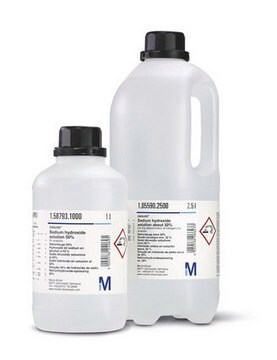S5904
Sodium metasilicate nonahydrate
BioReagent, suitable for plant cell culture, ≥98%
Sign Into View Organizational & Contract Pricing
All Photos(2)
About This Item
Empirical Formula (Hill Notation):
Na2O3Si · 9H2O
CAS Number:
Molecular Weight:
284.20
EC Number:
MDL number:
UNSPSC Code:
12352207
PubChem Substance ID:
NACRES:
NA.72
Assay:
≥98%
Recommended Products
product line
BioReagent
Quality Level
Assay
≥98%
technique(s)
cell culture | plant: suitable
application(s)
agriculture
SMILES string
O.O.O.O.O.O.O.O.O.[Na+].[Na+].[O-][Si]([O-])=O
InChI
1S/2Na.O3Si.9H2O/c;;1-4(2)3;;;;;;;;;/h;;;9*1H2/q2*+1;-2;;;;;;;;;
InChI key
PHIQPXBZDGYJOG-UHFFFAOYSA-N
Looking for similar products? Visit Product Comparison Guide
Application
Silicon (Si) has been reported to effectively manage some pests and diseases of plants.Exogenous application of silicon (Si) in the form of sodium metasilicate reduced disease development caused by Penicillium expansum and Monilinia fructicola in sweet cherry fruit at 20 degrees C. The inhibition of fruit decay was correlated closely with Si concentrations.
Sodium metasilicate nonahydrate has been used as a trace element additive in bronchial epithelial growth medium (BEGM) and air-liquid interface (ALI) medium for culturing primary human airway epithelial (hAE) cells to study airway biology, disease, and therapy related to respiratory tract diseases.
Biochem/physiol Actions
Silicon (Si) has been reported to effectively manage some pests and diseases of plants. External application of silicon (Si) in the form of sodium metasilicate to Penicillium expansum and Monilinia fructicola infected sweet cherry fruit, at 20 °C, decreased the disease progression. The inhibition of fruit decay has been inferred by the Si concentrations.
Signal Word
Danger
Hazard Statements
Precautionary Statements
Hazard Classifications
Eye Dam. 1 - Met. Corr. 1 - Skin Corr. 1B - STOT SE 3
Target Organs
Respiratory system
Storage Class Code
8A - Combustible corrosive hazardous materials
WGK
WGK 3
Flash Point(F)
Not applicable
Flash Point(C)
Not applicable
Personal Protective Equipment
dust mask type N95 (US), Eyeshields, Gloves
Choose from one of the most recent versions:
Already Own This Product?
Find documentation for the products that you have recently purchased in the Document Library.
Customers Also Viewed
Guo Z Qin et al.
Phytopathology, 95(1), 69-75 (2008-10-24)
ABSTRACT Exogenous application of silicon (Si) in the form of sodium metasilicate reduced disease development caused by Penicillium expansum and Monilinia fructicola in sweet cherry fruit at 20 degrees C. The inhibition of fruit decay was correlated closely with Si
Pest risk assessment of Monilinia fructicola for the EU territory and identification and evaluation of risk management options
EFSA Journal, 9, 2119-2119 (2011)
Management of root knot nematode, Meloidogyne incognita in cucumber (Cucumis sativus) using silicon.
C Dugui-Es et al.
Communications in agricultural and applied biological sciences, 75(3), 497-505 (2010-01-01)
Silicon (Si) has been reported to effectively manage some pests and diseases of plants. This study was conducted to determine the effect of Si concentration, mode, and frequency of application in managing Meloidogyne incognita in cucumber. A susceptible cultivar of
M Leslie Fulcher et al.
Methods in molecular biology (Clifton, N.J.), 945, 109-121 (2012-10-26)
Human airway epithelial (hAE) cell cultures are instrumental for studying basic and applied aspects of respiratory tract biology, disease, and therapy. When primary epithelial cells from the human nasal passages or tracheo-bronchial airways are grown on porous supports at an
Well-differentiated human airway epithelial cell cultures.
M Leslie Fulcher et al.
Methods in molecular medicine, 107, 183-206 (2004-10-20)
Our team of scientists has experience in all areas of research including Life Science, Material Science, Chemical Synthesis, Chromatography, Analytical and many others.
Contact Technical Service














